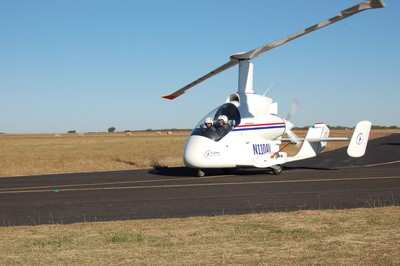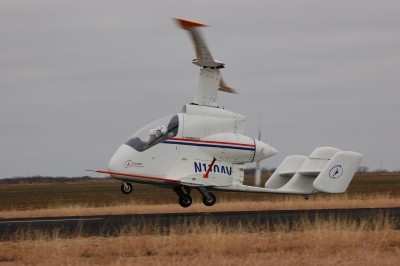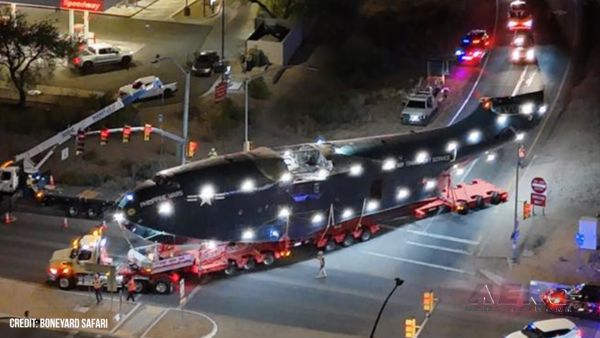Tue, Feb 01, 2011
Software Refinements Made For Improved Aircraft Control
Wichita Falls, TX-based Carter Aerospace Development said Monday
that they have completed the first phase of flight-testing of their
new Personal Air Vehicle (PAV). The PAV began flight-testing in
October 2010 with the goal of testing and refining the flight
control systems for the aircraft. Taxi tests were followed by short
hops down the runway and after each test refinements were made to
the aircraft controls. During each flight sensors on the aircraft
downloaded more than sixty (60) channels of information on the
aircraft's performance to the control room computer. Four cameras
also recorded the visual performance of the aircraft including the
pilots and controls in the cockpit. Almost all flight controls on
the PAV are automated and controlled by an on-board computer.
During testing the computer software was refined several times to
improve flight control and increase aircraft performance.

Carter PAV
The highlights of the Phase I flight-testing were the PAV's
first flight pattern on December 2, 2010, the first 30- minute +
flight on January 5, 2011 and the first jump take-off on January
18, 2011. According to Carter Aerospace President, Jay Carter, Jr.,
"We decided to breakdown the PAV flight-testing into two phases so
that it would be easier to validate the control functions of the
aircraft. For take-off and landing it's an autogyro. For cruise
it's a fixed-wing. We've now tested and refined the autogyro
segment proving that we have the capability to do jump take-offs
and zero-roll landings. This is a huge accomplishment for us. A
major advantage of our technology is its vertical take-off and
landing (VTOL) capability."

While the PAV only logged a few hours of flight time during
Phase I, it completed multiple take-offs and landings, including 8
jump take-offs. Much more extensive flight-testing will take place
during Phase II when Carter will add the 45-foot wing section to
the aircraft. With the wings added Carter will begin expanding the
flight envelope by transitioning the lift from the PAV's rotor to
the wing. With lift on the wings Carter can decrease the rotor rpm
and increase flight speed. This is the basis for Carter's patented,
Slowed Rotor/ Compound (SR/CTM) technology.
More News
Flight Recorder A general term applied to any instrument or device that records information about the performance of an aircraft in flight or about conditions encountered in flight>[...]
“We have the engine design; we have the integration plans for the launch airframe; we have the solutions to provide the hydrogen fuel; and we have the customers wanting to op>[...]
From 2024 (YouTube Edition): Innovative Pitch Control Eliminates Runway Accidents Aero-News Network’s Rex Alexander spoke with Herbie Lewis of ELA Aviación, who discus>[...]
Also: Tentative AirVenture Airshow Lineup, Supersonic Flight Regs, Private Pilot Oral Exam Guide, Boeing Deal The sport aircraft business can be a tough one... especially when Moth>[...]
Klyde Has No Patience... FMI: www.klydemorris.com>[...]
 ANN's Daily Aero-Term (05.18.25): Flight Recorder
ANN's Daily Aero-Term (05.18.25): Flight Recorder Aero-News: Quote of the Day (05.18.25)
Aero-News: Quote of the Day (05.18.25) Classic Aero-TV: ELA Aviation Sports New Vertical Takeoff Gyroplane
Classic Aero-TV: ELA Aviation Sports New Vertical Takeoff Gyroplane Airborne 05.19.25: Kolb v Tornados, Philippine Mars, Blackhawk Antler Theft
Airborne 05.19.25: Kolb v Tornados, Philippine Mars, Blackhawk Antler Theft Klyde Morris (05.16.25)
Klyde Morris (05.16.25)




